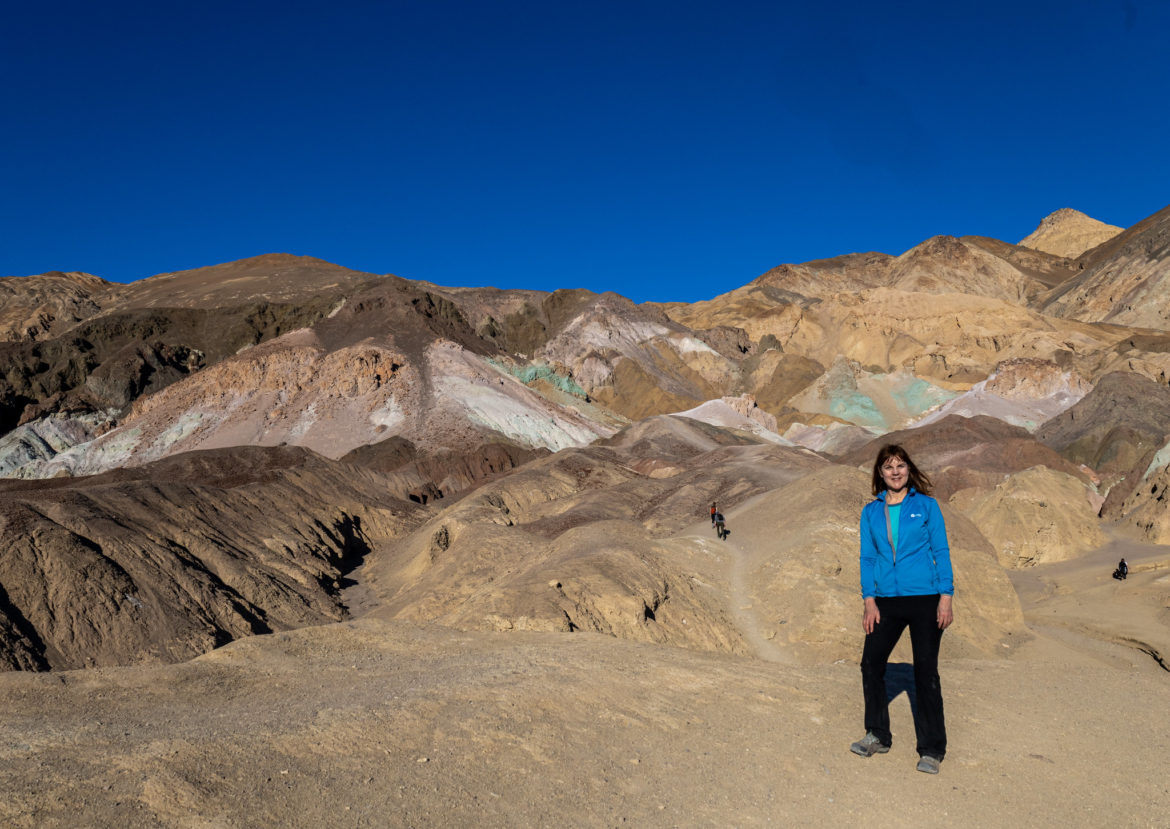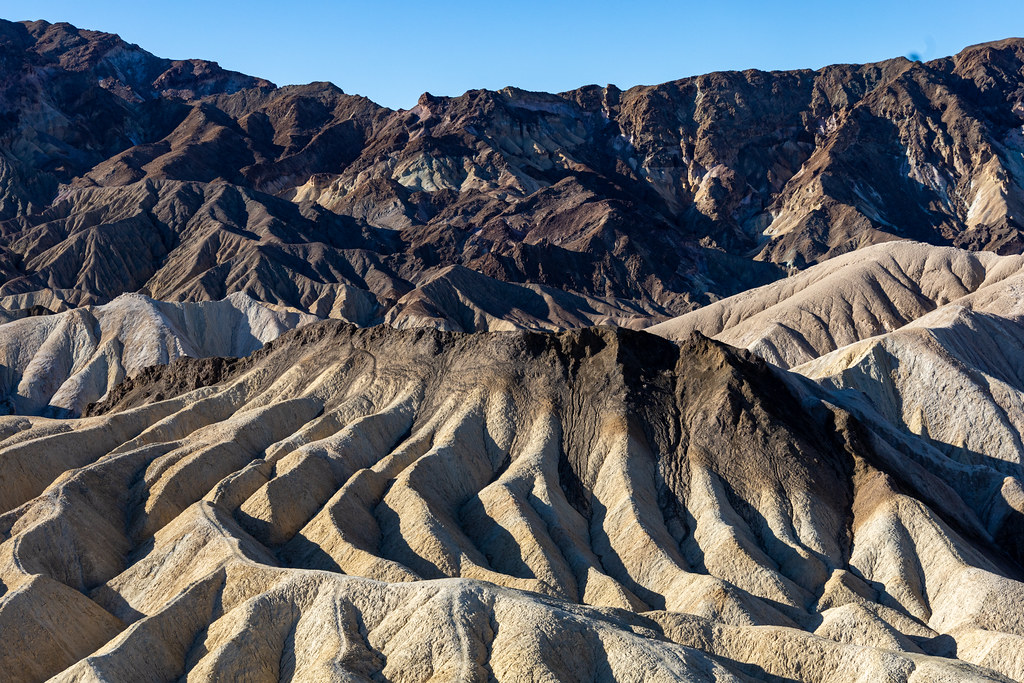This one-of-a-kind destination is the lowest (in western hemisphere), driest and hottest place on Earth. It is an otherworldly land of superlatives to say the least. Many people know about Death Valley being hot at a low elevation, however, most don’t realize how hauntingly beautiful it is. This desertscape captivates with diverse environments that make you feel like you are on another planet. In February, I spent 2 full days exploring this incredible park. Here’s my Death Valley top sites and tour tips for a 2-day itinerary.
About Death Valley National Park
Death Valley National Park is in the Mojave Desert, mostly in eastern California, with a small triangular area in Nevada. This is the largest park in the contiguous U. S. Its Badwater Basin salt-flats lie 282-feet below sea level as the lowest elevation in the western hemisphere.
In 2021 the temperature of the valley reached the highest on Earth’s record at 130 degrees. Overall, the park has diverse landscapes like salt-flats, badlands, valleys, sand dunes, valleys, canyons and mountains.
High season at Death Valley is October to May for comfortable temperatures. Spring is popular for colorful wildflowers. Superblooms are especially spectacular, however, those only happen on average every 10 years. Also, many services are limited in the off season. It’s not recommended to hike in the summer from extreme heat.
Two Main Visitor’s Centers
The Furnace Creek Visitor Center and Stovepipe Wells Village are the 2 main visitor centers in the park. Most people start their visit at the Furnace Creek Village where you purchase the $30 entrance fee. Overall, this is a great hub for getting information, maps and resources. Also, it’s close to many of the top attractions at the park. Twenty-five miles north of Furnace Creek Village is Stovepipe Wells. In comparison, it’s more scaled down with resources, but near other popular attractions.
Accommodations / Camping
The 4 top motels/resorts to stay in the park are the Inn at Death Valley, Ranch at Death Valley, Stovepipe Wells Hotel and Panamint Springs Resort. There are 12 campgrounds in the park and plenty of opportunities for backcountry camping. There’s additional lodging in the closest towns outside the park, such as, Beatty and Pahrump. These locations will cost less, however, they are both an hour drive from the park.
My 2-Day Solo Journey at Death Valley National Park
From Las Vegas, I rented a car and drove the 2.5-hour route to Death Valley National Park. I stayed at the Ranch at Death Valley in the Furnace Creek Village. It’s at a convenient location with comfortable amenities, restaurants and shops. (And it’s half the cost of the more expensive Inn at Death Valley.) I made my first stop at the Furnace Creek Visitor’s Center, where I picked up maps and gathered information. I visited the 8 top sites explained in this article and learned these tips:
Death Valley Tour Tips:
I suggest efficiently planning stops around key locations at the visitor centers. Many top sites are near Furnace Creek Village: Badwater Basin, Devil’s Golf Course, Artist’s Drive, Gold Canyon Trail, Zabriskie Point and Dante’s View. Plus, top sites near Stovepipe Wells are Mesquite Flat Sand Dunes and Mosaic Canyon. Overall, 2 days is enough to see these 8 attractions. However, ideally with 3 days you could include the more out-of-the-way and incredible Ubehebe Crater and The Racetrack, which I regretfully didn’t have time to see.
Related: First-timers Guide to Joshua Tree National Park
Death Valley Top Sites in 2 Days
Near Furnace Creek Village:
Badwater Basin
Here marks the lowest elevation in the western hemisphere at 282-ft below sea level, where visitors walk on the salt-flats. The path goes about 1-mile out to the most interesting area, where crystalized salt formations make intriguing patterns. The Black Mountains loom as the eastern backdrop painting a nice contrast to the white fields of salt.
Devil’s Golf Course
Off a half-mile gravel road is this intriguingly rugged landscape. Here, there is a vast field of crystalized salt formations that are sharp and hard. Use caution if you walk out on the field, as a fall could be harmful. One understands the name in the presence of this foreboding, yet mysterious landscape.
Golden Canyon Trail
This is the most popular hike at Death Valley N. P. with many variations for all levels from 3 – 7 miles. The trail intimately takes you through the labyrinth of the golden canyons and variegated badlands. Majestic, must-see landmarks along the way (depending on route) are Red Cathedral, Manly Beacon, Zabriskie Point and Gower Gulch.
Zabriskie Point
Near the Furnace Creek Visitor Center, this badlands landmark is a Death Valley favorite for many people. Both sunrise and sunset are a great time to be here and see the moving rays light up the colorful badlands. There is a lookout point with incredible views, as seen in my photo. Also, there is a Zabriskie Loop trail to hike and immerse in the shadows of the badlands and see them up close.
Don’t miss sunrise or sunset at the Artist’s Palette!
Artist’s Palette
The Artist Drive Scenic Loop is a one-way route that stops at the Artist’s Palette. A parking lot is here to access paths in the colorful hills. Volcanic deposits rich in compounds, such as, chlorite and iron oxides and chlorite splash the landscapes with a rainbow effect. It’s ideal to visit at sunrise and sunset with the changing lights enhancing the colors.
Dante’s View
About 16 miles south of Furnace Creek is this viewpoint terrace. It looms over the park at 5,476 ft on the north side of Coffin Peak, along the crest of the Black Mountains. Being on the east side of the valley this is a great place to watch the sun rise suffusing light throughout the valley floor. Many people also go here to stargaze for obvious reasons.
Near Stovepipe Wells:
Mesquite Flat Sand Dunes
These sand dunes are so much fun to get out and walk upon. It’s about a mile out to the highest one from the parking lot. The sands erode from the nearby mountains and carry from the north by the winds to the Tucki Mountains, causing the sand to collect in these exquisite dunes. Many creatures, such as, lizards, beetles and the sidewinder rattlesnakes live underneath the surface of the dunes.
Not to worry about the sidewinder snakes, as they normally come out at night and their bites are rarely fatal to humans. Sunrise or sunset is the best time to see the dunes with the mysterious lighting and shadows on the sand.
Mosaic Canyon Trail
Near the Mesquite Sand Dunes, this trail is a nice complement for unique scenery and landscapes. The is a moderate, 3.5-mile up and back trail through 2 narrows and a slot canyon. The beautiful mosaic rocks are an expression of Mother Nature as an artist. Especially in the slot canyon, the smooth marble is polished along the walls and ground to scramble over. Some areas are slippery and require caution but are not too difficult.
Also, If You Have More Time…
Don’t miss these sites if have more time, however, they are more out of the way: Ubehebe Crater, The Racetrack and Rhyolite, a ghost town (near Beatty). Sorry, I didn’t make it to these places. This gives me good reason to go back!
Stargazing at Death Valley: Death Valley N. P. is the largest Dark Sky National Park in the U.S. Because of its remote dark skies and minimal light pollution, it stages some of the world’s best stargazing. Also, at the Furnace Creek Visitor’s Center, there is astronomy lectures and meet-ups organized to share the stargazing experience with others and technology, such as, telescopes.
Overall, Death Valley Tour Tips
Planning is essential to enjoy this park because it is such a land of extremes and so vast. The weather, remote location with limited resources and rugged terrain require smart travel. And most importantly, safety is paramount, remembering this is the driest and hottest place on the planet. However, it’s also one of the most dramatic, humbling and enchanting to remind you about the power of Mother Earth.
Read More!
Forest Bathing in San Francisco’s Muir Woods, Exploring the Unique Redwoods
Must-See Tucson Botanical Gardens’ Highlights











